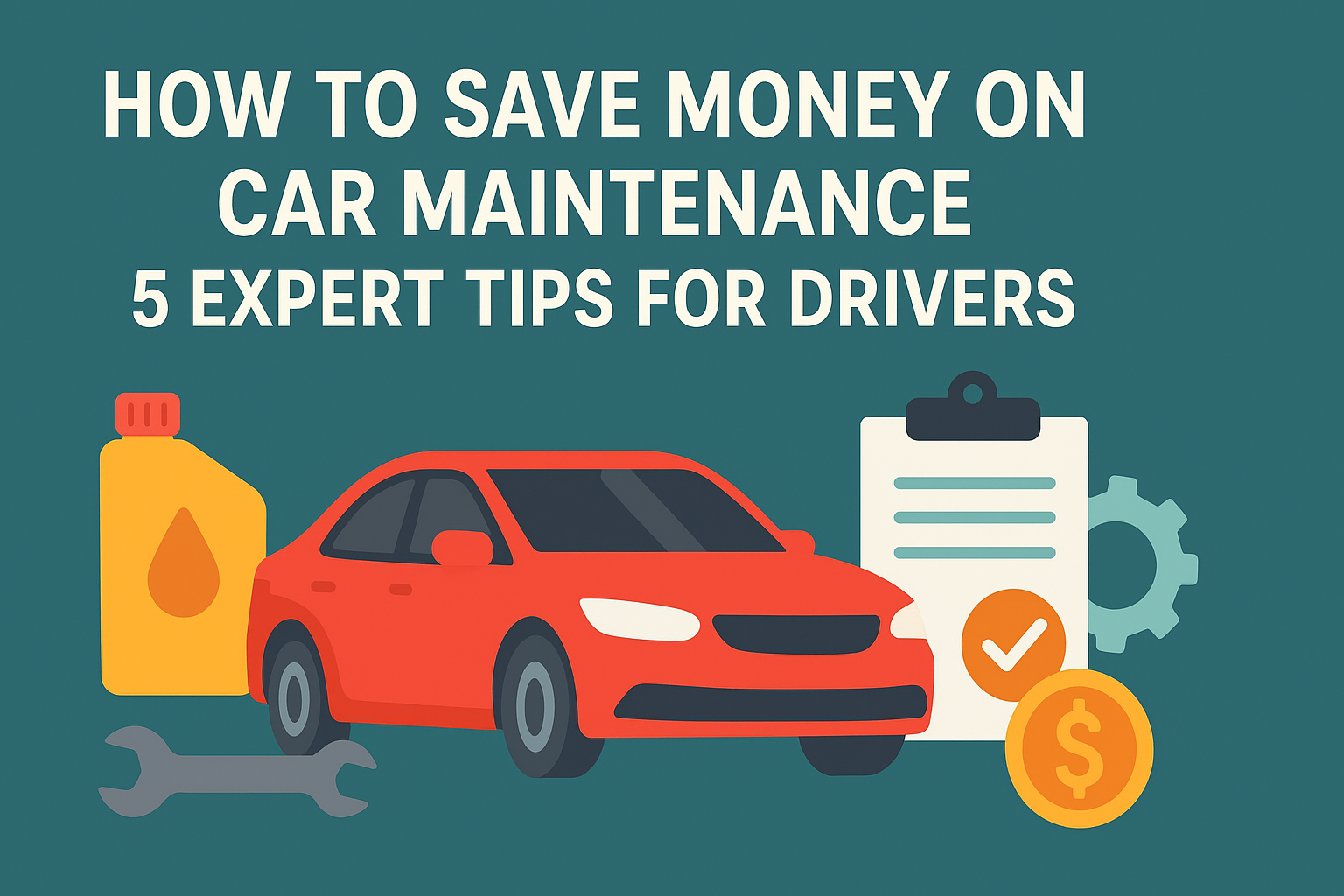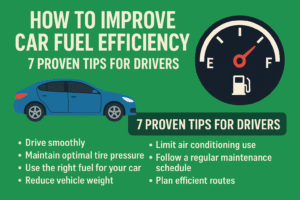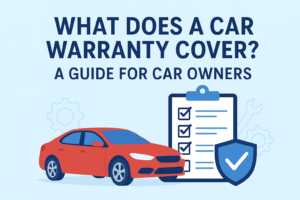Owning a car is a major investment, and with rising fuel prices and unexpected repairs, maintenance costs can add up quickly. However, by implementing smart strategies, drivers can significantly reduce these expenses while keeping their vehicles running smoothly. This comprehensive guide outlines 5 expert car maintenance tips to help you save money on car maintenance, drawing valuable insights from the Ultimate Car Care Guide by BuyingCarAssist. From practical DIY cleaning techniques to selecting the cheapest cars to maintain, these tips are designed for everyday drivers looking to extend vehicle lifespan, improve fuel economy, and avoid costly breakdowns.
Whether you’re commuting daily in a compact sedan or embarking on long road trips in an SUV, proactive vehicle upkeep is key to low-cost car ownership. Regular preventive maintenance not only enhances safety and performance but also boosts resale value. According to recent data from Consumer Reports (2025), well-maintained cars can save owners up to 20% on long-term repair costs compared to neglected vehicles. Ready to transform your approach to auto repair savings? Let’s explore these actionable car maintenance tips in detail.
Want personalized advice to cut your car maintenance costs? Book a consultation with BuyingCarAssist today and get expert guidance tailored to your needs!
Why Car Maintenance Matters for Drivers
In today’s fast-paced world, cars are essential for mobility, but harsh driving conditions like traffic congestion, varying weather, and rough roads can accelerate wear and tear. A consistent car maintenance schedule ensures reliability, prevents minor issues from escalating into major repairs, and optimizes overall vehicle performance. Neglecting routine checks can lead to problems such as engine failure, tire blowouts, or reduced fuel efficiency, resulting in higher costs over time.
Key Benefits of Proactive Vehicle Maintenance:
- Enhanced Safety: Regular inspections of brakes, tires, and lights reduce accident risks.
- Financial Savings: Early detection of issues avoids expensive fixes; for instance, a simple oil change prevents engine damage that could cost thousands.
- Better Fuel Economy: Maintained engines and tires improve mileage, cutting fuel expenses by up to 10-15%.
- Higher Resale Value: Cars with documented maintenance history sell for 10-20% more in the used market.
- Environmental Impact: Efficient vehicles emit fewer pollutants, contributing to greener driving.
By incorporating these car maintenance tips, drivers can achieve low-cost car ownership and enjoy peace of mind. Entities like JD Power and Consumer Reports emphasize that consistent upkeep is the foundation of reliable transportation.
5 Expert Tips to Save Money on Car Maintenance
Tip 1: Perform Regular DIY Cleaning
Why It Saves Money: Professional detailing services can cost $100-300 per session, but DIY cleaning prevents dirt buildup that leads to rust, paint degradation, and interior wear. Regular cleaning extends the life of components like upholstery and bodywork, reducing replacement needs.
Step-by-Step DIY Cleaning Guide:
- Exterior Washing: Use a pH-balanced car shampoo (brands like Meguiar’s or Turtle Wax, priced $10-20) and a microfiber mitt to gently remove grime. Wash every 1-2 weeks to combat environmental contaminants. Avoid high-pressure washers on sensitive areas to prevent damage.
- Interior Detailing: Vacuum carpets and seats monthly, then wipe surfaces with a mild cleaner. For leather or vinyl, apply conditioners to prevent cracking. Clean vents and crevices with compressed air cans ($5-10) to maintain air quality.
- Engine Bay Cleaning: Every 3-6 months, use a degreaser spray on a cool engine, avoiding electrical components. This prevents oil leaks and improves cooling efficiency.
- Wheel and Tire Care: Scrub brakes and rims with a wheel cleaner to remove brake dust, which can corrode alloys if left unchecked.
Common Mistakes to Avoid: Using household detergents, which strip protective wax, or washing in direct sunlight, causing water spots. Instead, park in shade and apply a wax sealant quarterly for added protection.
Pro Tip: Incorporate air filter cleaning into your routine to boost engine performance and fuel efficiency. For more detailed instructions, refer to the Ultimate Car Care Guide.
Savings Estimate: $500-1,000 annually by skipping professional services and preventing premature wear.
Additional Benefits: DIY cleaning fosters a deeper understanding of your vehicle, allowing early spotting of issues like fluid leaks or tire tread wear, further supporting preventive maintenance.
Tip 2: Follow a Smart Maintenance Schedule
Why It Saves Money: Adhering to a manufacturer-recommended schedule prevents breakdowns and extends part life. Data from Kelley Blue Book (2025) shows average annual maintenance costs around $900, but scheduled checks can reduce this by 30% through early intervention.
Recommended Car Maintenance Schedule (Based on Mileage):
- Every 3,000-5,000 Miles (or 3-6 Months):
- Change engine oil and filter ($30-80, DIY possible).
- Inspect and rotate tires for even wear ($20-50).
- Check fluid levels (brake, coolant, transmission) and top up as needed.
- Every 10,000-15,000 Miles (or 6-12 Months):
- Replace air and cabin filters ($20-50).
- Inspect brakes, belts, and hoses for cracks or wear.
- Align wheels if uneven tire wear is noticed ($60-100).
- Every 30,000 Miles (or 2-3 Years):
- Flush and replace transmission fluid ($100-200).
- Change spark plugs in gasoline engines ($50-150).
- Inspect suspension and steering components.
- Every 60,000 Miles (or 5 Years):
- Replace timing belt or chain if applicable ($500-1,000, critical to avoid engine damage).
- Flush coolant system and replace radiator hoses.
- Every 90,000 Miles (or 7-8 Years):
- Comprehensive inspection of fuel system, including injectors and pump.
- Replace battery if showing signs of weakness (average lifespan 3-5 years).
Customization Tips: Electric vehicles (EVs) require less frequent checks (e.g., no oil changes), focusing on battery health and software updates. Hybrids blend gas and electric needs. Always consult your owner’s manual for model-specific advice.
Common Mistakes: Overlooking seasonal checks, like winterizing batteries or summer tire pressure adjustments. Use apps like MyCarfax for reminders.
Pro Tip: Track mileage with a logbook or app to stay on schedule. For personalized plans, explore BuyingCarAssist’s Car Consultation Services.
Savings Estimate: $1,000-3,000 over 5 years by averting major repairs.
Case Study Example: A driver following this schedule on a Honda Civic reported only $2,500 in maintenance over 100,000 miles, versus $5,000 for irregular upkeep, per Consumer Reports data.
Tip 3: Choose the Right Car for Low Maintenance Costs
Why It Saves Money: Selecting vehicles with reliable engineering, affordable parts, and strong warranties minimizes long-term expenses. Brands like Toyota and Honda consistently rank high in reliability surveys, with 10-year ownership costs 20-30% lower than average.
Factors Influencing Low Maintenance Costs:
- Part Availability and Cost: Models with common components (e.g., Toyota Corolla filters at $10-20) are cheaper to repair.
- Warranty Coverage: Extended warranties (5-10 years) from manufacturers like Kia cover major issues.
- Reliability Ratings: Check sources like JD Power for models with fewer reported problems.
- Fuel Type: Hybrids and EVs often have fewer moving parts, reducing mechanical failures.
Pro Tip: Before purchasing, use the Car Affordability Calculator to estimate total ownership costs, including maintenance.
Savings Estimate: $2,000-5,000 over 5 years compared to high-maintenance luxury models.
Additional Considerations: Factor in driving habits—city commuters benefit from compact cars, while highway drivers may prefer sedans for better aerodynamics and lower tire wear.
Tip 4: Optimize Fuel Efficiency
Why It Saves Money: Fuel accounts for 30-40% of ownership costs, with global prices fluctuating. Improving efficiency by 10% can save hundreds annually, per the 2025 Fuel Economy Guide from the U.S. Department of Energy.
Proven Fuel Efficiency Tips:
- Smooth Driving Habits: Maintain steady speeds; aggressive acceleration wastes fuel. Studies show smooth driving saves 5-10% on gas.
- Tire Maintenance: Keep pressure at recommended levels (32-35 PSI for most cars) to avoid 3-5% mileage loss from underinflation.
- Aerodynamic Adjustments: Remove roof racks when not in use to reduce drag by up to 20%.
- Engine Tune-Ups: Clean fuel injectors every 30,000 miles to maintain optimal combustion.
- Eco-Friendly Choices: Use the correct octane fuel; overusing premium in standard engines is wasteful.
- Idling Reduction: Turn off the engine during stops longer than 30 seconds to save 1-2% fuel.
Advanced Strategies for 2025: Leverage vehicle tech like eco-modes in modern cars or apps for route optimization. For EVs, precondition batteries for efficient charging.
Pro Tip: Monitor consumption with the Fuel Cost Calculator to identify savings opportunities.
Savings Estimate: $300-800 per year, depending on mileage.
Environmental Angle: Better efficiency reduces carbon emissions, aligning with global sustainability goals from entities like the EPA.
Tip 5: Shop Smart for Parts and Services
Why It Saves Money: Comparing options can slash costs by 40%, as independent shops often charge less than dealerships for the same work.
Smart Shopping Strategies:
- Compare Repair Shops: Use reviews from sites like Yelp or Angi for reputable independents offering 20-30% lower labor rates.
- Source Parts Wisely: Buy OEM or aftermarket parts online from retailers like AutoZone or RockAuto (e.g., brake pads $30-60 vs. $100 at dealers).
- Bundle Services: Combine oil changes with inspections for discounts.
- Warranty Claims: Use manufacturer warranties for covered repairs to avoid out-of-pocket expenses.
- DIY Where Possible: Simple tasks like battery replacement save $50-100 in labor.
Common Pitfalls: Falling for upsells like unnecessary alignments; always question recommendations.
Pro Tip: Consult BuyingCarAssist experts for vetted part suppliers and service advice.
Savings Estimate: $400-1,200 annually on repairs.
Long-Term Strategy: Build relationships with trusted mechanics for loyalty discounts.
Cheapest Cars to Maintain
Opting for reliable models is crucial for low-cost ownership. Based on 2025 data from CarEdge and Consumer Reports, here are the cheapest cars to maintain, focusing on low repair frequency and part costs.
Detailed Overviews:
- Toyota Prius: Hybrid efficiency with minimal mechanical issues; battery warranties last 8-10 years.
- Honda Civic: Durable engine and widespread parts availability make it a top choice for commuters.
- Toyota Corolla: Legendary reliability; averages under $400/year in maintenance after warranty.
- Hyundai Sonata: Strong warranty (10 years/100,000 miles) covers powertrain, reducing costs.
- Kia K5: Affordable repairs with extensive coverage, ideal for families.
Table: Top 5 Affordable Cars to Maintain
| Car Model | Brand | Avg. Annual Maintenance Cost | Key Features | Why It’s Affordable |
| Toyota Prius | Toyota | $400-600 | 50+ mpg hybrid | Few moving parts, long warranty |
| Honda Civic | Honda | $450-650 | Reliable engine | Cheap parts, high durability |
| Toyota Corolla | Toyota | $400-550 | 30-40 mpg | Proven track record, easy repairs |
| Hyundai Sonata | Hyundai | $500-700 | Spacious sedan | Extended warranty coverage |
| Kia K5 | Kia | $450-650 | Modern tech | Affordable spares, reliable build |
Note: Costs based on 2025 averages; vary by usage and location.
Curious about ownership costs? Try our Car Affordability Calculator for a custom breakdown!
How BuyingCarAssist Can Help
At BuyingCarAssist, our mission is to empower drivers with tools and expertise for efficient vehicle upkeep. The Ultimate Car Care Guide covers everything from engine tuning to tire rotation, helping you implement these car maintenance tips effectively. Our consultations (starting at $25) provide customized advice on selecting cheapest cars to maintain, optimizing schedules, and sourcing parts.
Why Partner with Us?
- Expert Insights: Engineers and auto specialists offer real-world solutions.
- Resource Hub: Free calculators and guides for proactive planning.
- Global Testimonials: Satisfied clients worldwide praise our hassle-free support.
Take the next step—book a consultation with BuyingCarAssist and unlock savings on your car maintenance!
Frequently Asked Questions
Q: How often should I change my car’s oil?
A: Every 3,000-5,000 miles for conventional oil; synthetic lasts 7,500-10,000. Check your manual or consult BuyingCarAssist for specifics.
Q: What are the cheapest cars to maintain for families?
A: Models like the Toyota Corolla or Honda Civic offer low costs with spacious designs. See our table for options.
Q: Can DIY maintenance void my warranty?
A: No, as long as you use approved parts and document work. The Ultimate Car Care Guide explains warranty-safe practices.
Q: How does fuel efficiency impact maintenance costs?
A: Better mileage reduces engine strain, lowering repair needs. Use our Fuel Cost Calculator to optimize.
Q: What’s the average annual car maintenance cost?
A: Around $800-900, per 2025 data, but following tips can cut it in half.
Q: Are EVs cheaper to maintain than gas cars?
A: Yes, with no oil changes and fewer parts; focus on battery health.
Q: How do I find reliable parts online?
A: Shop from trusted sites; BuyingCarAssist consultations recommend sources.
Conclusion
Mastering car maintenance tips is essential for drivers seeking to save money on car maintenance and enjoy reliable, efficient vehicles. By embracing DIY cleaning, adhering to schedules, choosing cheapest cars to maintain, optimizing fuel use, and shopping wisely, you can minimize expenses while maximizing performance. These strategies, supported by the Ultimate Car Care Guide, empower you to take control of your auto upkeep and avoid common pitfalls.
Remember, preventive maintenance is an investment in longevity—pair it with expert advice from BuyingCarAssist for optimal results. Whether you’re a daily commuter or weekend adventurer, these tips ensure worry-free driving.
Don’t wait for repairs to pile up—book a consultation with BuyingCarAssist now and start saving today!







